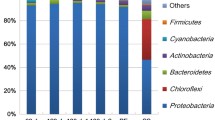The composition of mercury-reducing communities in two bioreactors retaining Hg(II) from chloralkali electrolysis wastewater for 485 days was analyzed based on effluent community DNA. Packed bed bioreactors with lava chips as carrier of the biofilm were inoculated with nine Hg(II)-resistant isolates that belonged to the alpha and gamma subdivisions of the proteobacteria. A rapid DNA-fingerprinting method was applied, using the intergenic spacer region (ISR) of the 16S-23S rDNA for analysis of the community composition. This allowed discrimination of the inoculum strains down to subspecies level. A merA specific PCR permitted the discrimination of the community's merA genes. During the 485 days of operation, the bioreactors were exposed to various physical stresses (mixing, gas bubbles, temperature increase up to 41°C, increased flow velocity) and repeated high mercury inflow concentrations, resulting in reduced bioreactor performance and decreased culturable cell numbers in the reactor effluent. Nevertheless, the composition of the microbial community remained rather stable throughout the investigated time period. Of the inoculum strains, two could be detected throughout, whereas three were sometimes present with varying periods of nondetection. Two inoculum strains were only detected within the first month. Two strains of gamma-proteobacteria that were able to reduce ionic mercury invaded the bioreactor community. They did not outcompete established strains and had no negative effect on the Hg(II)-retention activity of the bioreactors. The community comprised diverse merA genes. The abundance of merA genes matched the abundance of their respective strains as confirmed by ISR community analysis. The continuously high selection pressure for mercury resistance maintained a stable and highly active mercury-reducing microbial community within the bioreactors.
Similar content being viewed by others
Author information
Authors and Affiliations
Additional information
An erratum to this article is available at http://dx.doi.org/10.1007/s00248-002-0010-y.
Rights and permissions
About this article
Cite this article
Canstein, H., Li, Y., Felske, A. et al. Long-Term Stability of Mercury-Reducing Microbial Biofilm Communities Analyzed by 16S-23S rDNA Interspacer Region Polymorphism. Microb Ecol 42, 624–634 (2001). https://doi.org/10.1007/s00248-001-0028-6
Issue Date:
DOI: https://doi.org/10.1007/s00248-001-0028-6




